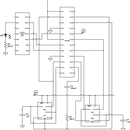Introduction: Super Simple Speaker
These are instructions for making your own loudspeaker with just a few parts and supplies.
1. Magnet wire
2. Clear plastic Tape (packing tape),
3. A magnet or stack of magnets
4. Scissors or a knife
5. audio cables/adapters
6. audio source (preferably including a battery powered amplifier)
optional materials:
Alligator clips
Bigger/stronger magnets
1. Magnet wire
2. Clear plastic Tape (packing tape),
3. A magnet or stack of magnets
4. Scissors or a knife
5. audio cables/adapters
6. audio source (preferably including a battery powered amplifier)
optional materials:
Alligator clips
Bigger/stronger magnets
Step 1: Tape
Unroll some tape sticky side up.
Use the magnets to hold the tape in place.
Use the magnets to hold the tape in place.
Step 2: Coil
Make a coil using the magnet wire.
If you leave space between your fingers you can wrap the wire around two or three fingers.
The space is important for safety and ease of removing the wire.
Leave extra wire at both ends of the coil.
If you leave space between your fingers you can wrap the wire around two or three fingers.
The space is important for safety and ease of removing the wire.
Leave extra wire at both ends of the coil.
Step 3: Laminate
Stick the coil to the tape, leaving the two wires at each end of the coil exposed.
Fold the tape over onto the coil.
If needed use a second piece of tape to laminate the tape/coil.
Fold the tape over onto the coil.
If needed use a second piece of tape to laminate the tape/coil.
Step 4: Wire Prep
The coating on the magnet wire is an insulator. it must be removed to connect the coil to an audio cable.
Use scissors or a knife that you don't mind getting dull to scrape off the insulator coating.
We found that the backside of the scissors worked well (and safely) and was less likely to cut the very thin wire.
Use scissors or a knife that you don't mind getting dull to scrape off the insulator coating.
We found that the backside of the scissors worked well (and safely) and was less likely to cut the very thin wire.
Step 5: Connect to Audio
For this step, we recommend using a battery powered amplifier to boost the signal from your audio device for most satisfactory results. DANGER: Please do not use an amplifier that is plugged into the wall.
But you may also connect to the headphone output of your iPhone or Laptop.
The resulting sounds will be much more difficult to hear at a distance (much like headphones).
In the photo below, we have connected the coil to an audio adaptor connected to an iPhone.
Then placed the magnets on the tape/coil laminate. Be sure to connect one end of the coil/wire to the Tip of the audio connector, and the other end of the coil/wire to the Sleeve of the audio connector.
Please keep in mind, that this will produce a very quiet signal (similar to that of headphones), you may find that you need to hold the speaker near your ear to hear it.
But you may also connect to the headphone output of your iPhone or Laptop.
The resulting sounds will be much more difficult to hear at a distance (much like headphones).
In the photo below, we have connected the coil to an audio adaptor connected to an iPhone.
Then placed the magnets on the tape/coil laminate. Be sure to connect one end of the coil/wire to the Tip of the audio connector, and the other end of the coil/wire to the Sleeve of the audio connector.
Please keep in mind, that this will produce a very quiet signal (similar to that of headphones), you may find that you need to hold the speaker near your ear to hear it.
Step 6: Optional Aligator Clips
Keeping the magnet wire in good conductive contact with the audio cable/adapter is essential for this to work. When moving the coil/wire around we found that it was difficult to keep good contact. So we used aligator clips to make better connections.
The aligator clips may slip off the Sleeve of 1/4" cable adapters. We have also used 1/8" adaptors. The aligator clips stay on those without much effort, but risk touching each other, thus short circuiting.
The aligator clips may slip off the Sleeve of 1/4" cable adapters. We have also used 1/8" adaptors. The aligator clips stay on those without much effort, but risk touching each other, thus short circuiting.











